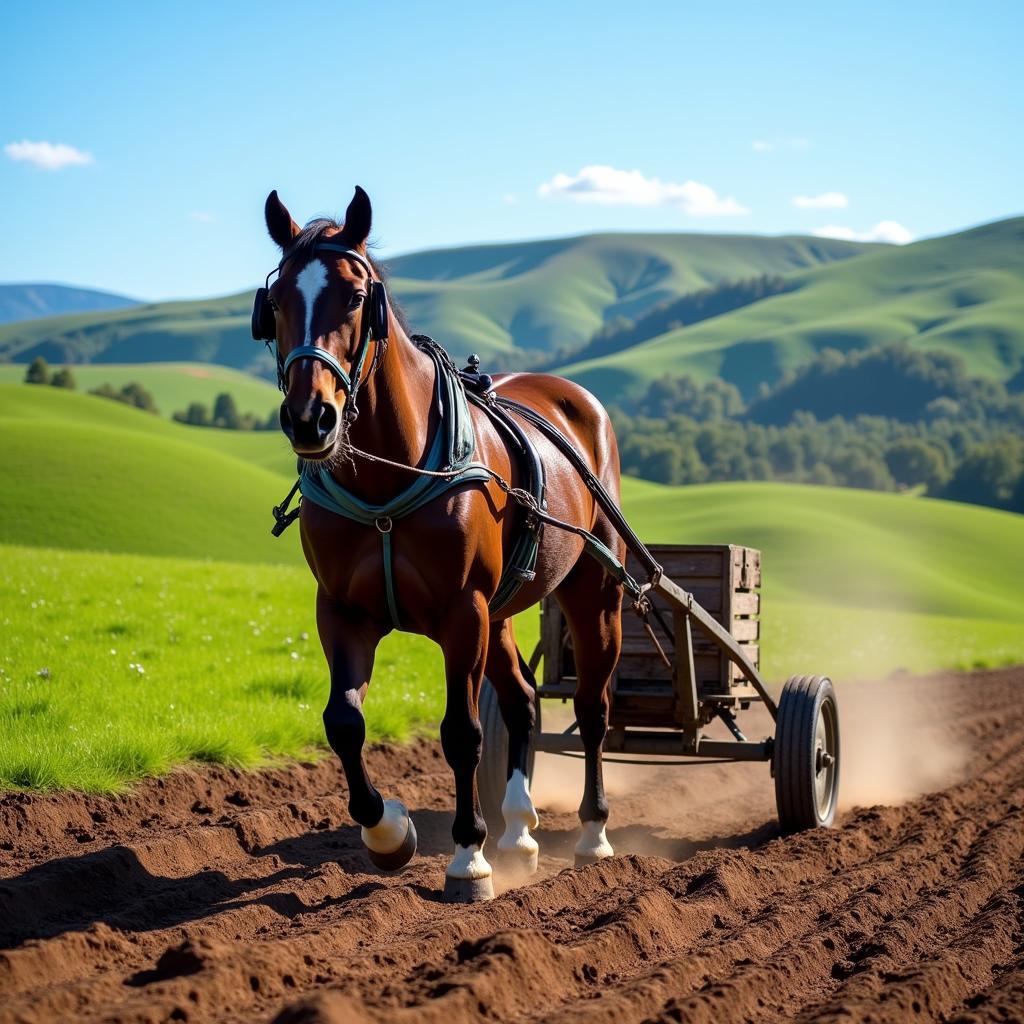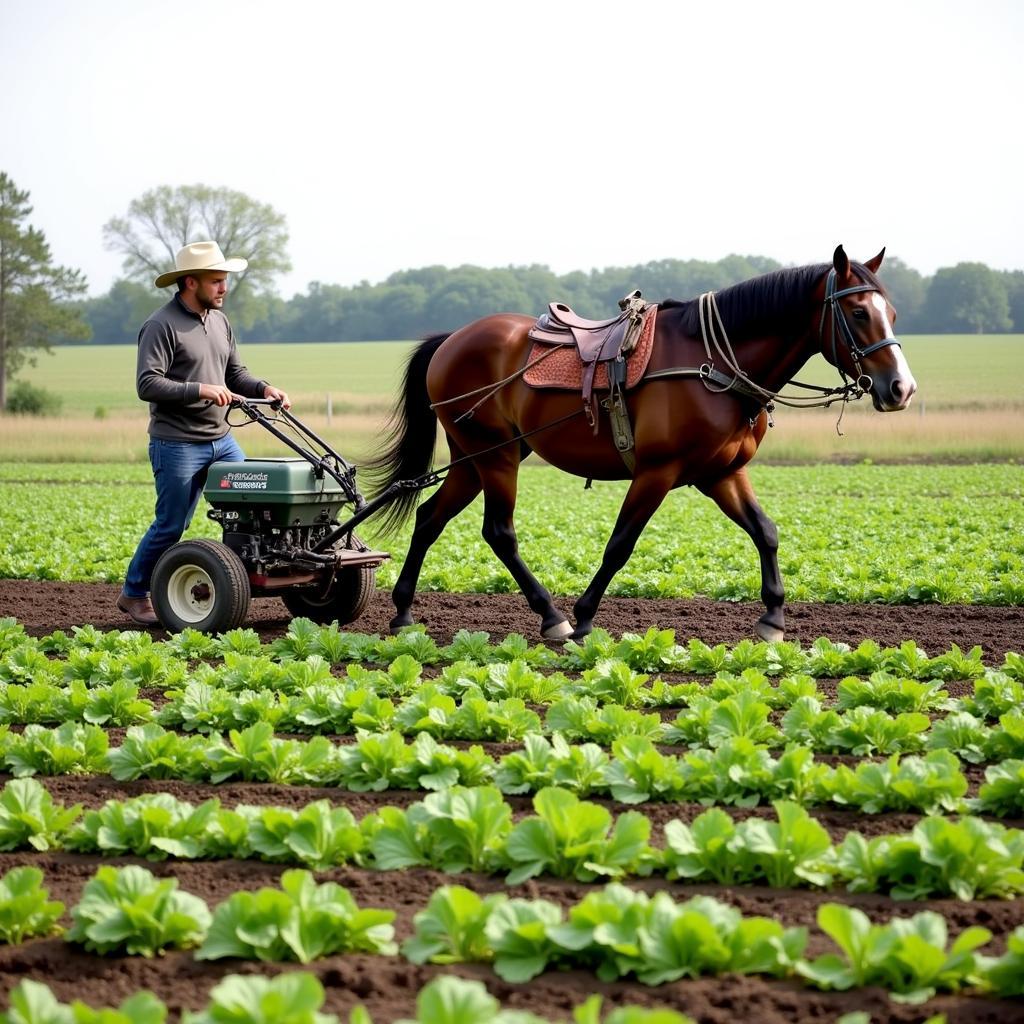Horse Drawn Produce Farms offer a compelling blend of tradition and sustainability in today’s agricultural landscape. These farms utilize the power of horses instead of machinery, resulting in a lower environmental impact and often, higher quality produce. From plowing fields to transporting harvested crops, horses play a vital role in every step of the process.
The Benefits of a Horse Drawn Produce Farm
Choosing to operate a horse drawn produce farm offers several significant advantages. Firstly, the environmental impact is dramatically reduced. There’s no reliance on fossil fuels, minimizing carbon emissions and air pollution. The gentle nature of horse-powered cultivation also leads to less soil compaction, promoting healthier soil structure and water retention. This contrasts sharply with the heavy machinery often used in conventional farming, which can damage soil health over time. Secondly, the slower pace of horse-drawn farming often allows for more careful attention to detail, resulting in higher quality produce. This meticulous approach can lead to less crop damage during harvest and a greater focus on selecting only the best produce. Lastly, these farms often foster a deeper connection between the farmer, the land, and the community. The presence of horses creates a unique and engaging environment, often attracting visitors and strengthening local food systems. You can learn more about the power of horses in agriculture on our page about horse powered farming.
 Horse drawn plow cultivating a field on a sustainable farm
Horse drawn plow cultivating a field on a sustainable farm
Setting Up Your Horse Drawn Produce Farm
Starting a horse drawn produce farm requires careful planning and consideration. Choosing the right breed of horse is paramount. Draft horses, known for their strength and gentle temperament, are ideal for farm work. Breeds like Percherons, Belgians, and Clydesdales are popular choices. Acquiring the necessary equipment is another crucial step. This includes plows, cultivators, harrows, and wagons, all designed specifically for horse-drawn operation. Check out our article on the horse drawn farm wagon to learn more. Understanding the land is also essential. Soil type, topography, and water availability all influence the success of a horse-drawn operation. Sustainable land management practices, such as crop rotation and cover cropping, are vital for maintaining soil health and fertility.
 Draft horse pulling a cultivator on a produce farm
Draft horse pulling a cultivator on a produce farm
Managing a Horse Drawn Produce Farm
Daily operations on a horse drawn produce farm revolve around the well-being of the horses. Providing adequate feed, water, and shelter is essential. Regular veterinary care and farrier services are crucial for maintaining the horses’ health and ensuring they are fit for work. Developing a strong understanding of horse behavior and training techniques is also key to a successful operation. Learning how to communicate effectively with your horses will enhance their performance and ensure their safety. Just as a thorough horse breeder job description requires a deep understanding of horses, so too does the success of a horse-drawn produce farm. Efficiently managing time and resources is another critical aspect. Planning work schedules based on the horses’ capabilities and the seasonal demands of the farm is crucial for maximizing productivity.
Challenges and Rewards of Horse Drawn Farming
While horse drawn produce farming offers many rewards, it also presents unique challenges. The pace of work is slower compared to mechanized farming, requiring more time and labor. Finding skilled individuals experienced in handling draft horses and operating horse-drawn equipment can also be difficult. The initial investment in horses and equipment can be substantial. However, the rewards of this sustainable approach to agriculture are numerous, including environmental stewardship, high-quality produce, and a deeper connection to the land. Choosing a horse drawn disk can significantly improve the efficiency of your tillage operations.
Conclusion
Horse drawn produce farms represent a viable and sustainable alternative to conventional agriculture. By embracing the power of horses, these farms minimize their environmental impact, often produce higher quality food, and foster stronger community connections. While challenges exist, the rewards of horse-drawn farming are substantial, offering a fulfilling and environmentally conscious approach to food production. If you are interested in learning more about the world of draft horses, you might want to know about measuring horse height, such as understanding what a 17 hands horse looks like.
FAQ
- What are the main benefits of a horse drawn produce farm? Reduced environmental impact, higher quality produce, and stronger community connections.
- What type of horses are best for horse drawn farming? Draft horses like Percherons, Belgians, and Clydesdales.
- What equipment is needed for a horse drawn produce farm? Plows, cultivators, harrows, and wagons designed for horse-drawn operation.
- What are the challenges of horse drawn farming? Slower pace of work, finding skilled labor, and initial investment costs.
- What are the rewards of horse drawn farming? Environmental stewardship, high-quality produce, and a deeper connection to the land.
- How can I learn more about horse-drawn equipment? Research online and visit local agricultural suppliers.
- Are there resources available to help me start a horse-drawn farm? Yes, various organizations and agricultural extension services offer support.
Common Scenarios and Questions
Scenario: You’re considering transitioning to horse-drawn farming but are unsure about the initial investment. Question: How can I find affordable horse-drawn equipment?
Scenario: You’re concerned about the time commitment required for horse-drawn farming. Question: How can I optimize efficiency on a horse-drawn farm?
Scenario: You’re interested in connecting with other horse-drawn farmers. Question: Where can I find a community of horse-drawn farmers?
Further Exploration
Explore more related articles on our website about horse-powered farming and horse-drawn equipment. Learn about different draft horse breeds and their specific capabilities.
Contact Us
For assistance, please contact us at Phone: 0772127271, Email: [email protected] or visit our address: QGM2+WX2, Vị Trung, Vị Thuỷ, Hậu Giang, Việt Nam. We have a 24/7 customer support team.